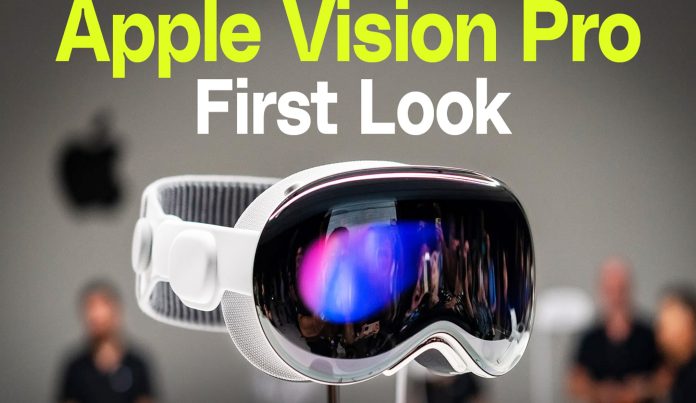
Apple Vision Pro is coming — here’s everything you need to know about Apple’s ‘Spatial Computing’ headset.
Discover everything you need to know about the upcoming Apple Vision Pro – Apple’s groundbreaking “Spatial Computing” headset. Anticipated to hit the market in the coming weeks, the device was initially unveiled at WWDC 2023 and is projected for an early 2024 release.
Equipped with the cutting-edge technology of augmented reality software, the Apple Vision Pro offers a versatile experience, enabling users to engage in activities ranging from watching TV shows to collaborating on projects. Whether you’re immersed in gaming or participating in video calls with friends, the headset seamlessly integrates these applications into the real world around you.
Boasting the power of dual 4K displays, a high-performance Apple silicon processor equivalent to that found in MacBooks, and advanced features like hand and eye tracking, the device goes beyond the surface. Additionally, it incorporates a Digital Crown, allowing users to adjust the level of immersion and seamlessly transition between the virtual and real world.
Recent reports suggest that the launch of the Apple Vision Pro is imminent, with speculation pointing towards a January 2024 release. While this may seem ambitious, it is evident that Apple is committed to unveiling the headset by March, as indicated by the official update of its release window to “early 2024.” Stay tuned for the latest updates on this revolutionary spatial computing device.
Apple has established a specialized Augmented Reality (AR) division to manage forthcoming Vision launches, underscoring its integral role in the company’s long-term strategy. The upcoming headset is slated to be priced at $3,499 and will initially be available in the U.S., with additional countries set to follow suit. As developers are actively crafting applications for Vision Pro and a collaborative alliance is being forged to champion an open standard for 3D content creation, the prospects for Vision Pro appear promising. This overview provides comprehensive insights into everything you should know about it.
Visit Us To Know More Updates: https://www.indiatimelines.com
Overview of Apple Vision Pro:
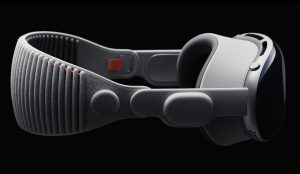
The Apple Vision Pro is a wearable “Spatial Computer” designed for augmented reality interactions and tasks. It boasts two 4K displays, hand-tracking capabilities, and an external display that enables people around you to view your face while using the device.
The headset’s lenses, positioned in front of two small screens, enable users to perceive digital content as if it exists in the real world. Apple aims to enhance various aspects of user experiences, such as providing a more immersive feel to meetings, transforming movies into larger-than-life screen sizes, and enabling workers to interact with applications on a larger canvas compared to traditional hardware monitors.
Distinguishing itself from many previous VR headsets, Apple prefers not to categorize the Vision Pro as ‘virtual reality.’ Notably, the Vision Pro eliminates the need for external controllers for navigation, relying instead on eye-tracking technology and hand gestures. The headset is equipped with a multitude of onboard sensors, allowing it to accurately track even subtle movements like a pinch between the user’s finger and thumb, even when the hand is at rest in their lap.
The headset retains some physical controls, with the Digital Crown being the most notable, making a return from the Apple Watch. In this context, it is utilized to adjust the level of immersion, allowing users to control the visibility of the real world around them. It also plays a crucial role in Apple’s Vision Pro ‘Environments’ feature, which introduces digitized locations such as forests or the surface of the moon, seamlessly blending with the viewer’s real-world surroundings.
If text input seems challenging, there’s a solution – users can focus on a search field and start dictating. Moreover, the Apple Vision Pro goes beyond that by identifying items, text, and more through visual analysis, resembling a more advanced version of Visual Lookup.
This overview only scratches the surface. Keep reading for a comprehensive exploration of all the details available about Vision Pro at this point.
APPLE VISION PRO: HARDWARE, INTERNAL SPECS, AND DESIGN
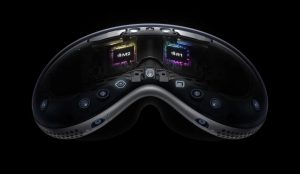
The Apple Vision Pro operates on the synergy of two key chips. Firstly, there’s the robust M2 chip, renowned for its prowess in MacBook computers, serving as a versatile computational unit. Complementing this is the innovative R1 chip (with ‘R’ denoting ‘Reality’), exclusively designed to process data from the Vision Pro’s extensive array of sensors, cameras, and microphones.
The Vision Pro employs a minimum of 10 external cameras to capture the user’s surroundings comprehensively. This includes a pair of forward-facing cameras, four downward-facing ones, two TrueDepth cameras for depth analysis, and two side-facing cameras to encompass the peripheral view. Additionally, four infrared cameras are dedicated to tracking in low-light conditions, both within and beyond the headset.
Enhancing its sensory capabilities, the Vision Pro incorporates a LiDAR sensor for distance mapping, along with accelerometers and gyroscopes for precise tracking of orientation and movement.
Notably, the headset boasts a potentially substantial storage capacity, surpassing that of the average MacBook Pro and many top-tier iPhones. Although specifics are yet to be confirmed by Apple, it is speculated to reach up to 1TB.
Let’s turn our attention to the external aesthetics next. The Apple Vision Pro boasts a distinctive design that draws inspiration from various products in Apple’s lineup, incorporating elements from the AirPods Pro Max, Apple Watch, and existing headset designs. Constructed with a blend of aluminum, plastics, and fabric mesh, the overall appearance exudes a 70s sci-fi vibe, reminiscent of something one might find in a NASA setting with its combination of grays, whites, and orange highlights.
Delivering a predominantly hands-free experience, the Vision Pro features two prominent hardware controls. Positioned on the top right edge of the headset’s front section is a Digital Crown, akin to the one found on an Apple Watch. This dial allows users to adjust the level of immersion for the headset experiences, seamlessly controlling the intensity of digital overlays on their real-world surroundings. On the left-hand side, there is a dedicated camera button for capturing 3D photos and videos.
A plastic band connects the front gasket to an adjustable fabric grip at the rear, with a Fit Dial on the side enabling users to snugly secure the headset onto their head. The rear support is crafted from a stretchy breathable mesh, enhancing comfort by distributing weight effectively. Similarly, the Light Seal surrounding the forehead, eyes, and nose is generously padded for maximum comfort, available in various sizes and designed to block ambient light for an optimal viewing experience of the internal screens. Individuals wearing prescription glasses may find it challenging to fit them into the headset, but Apple has collaborated with eye care specialists ZEISS to offer custom prescription lens inserts that magnetically attach to the inside of the headset, ensuring a clear view. While the pricing for this customization is yet to be determined, it is expected to be relatively high.
Spatial Audio-capable speakers are housed in pods on either side of the plastic strip connecting the front and rear parts of the headset. Positioned over, rather than in, the ears, these speakers enable ambient noises to be heard while wearing the headset.
Lastly, the Apple Vision Pro includes an external battery pack designed to sit in the user’s pocket. Connected via a cable to the side of the headset band using a MagSafe puck, this setup, while appearing somewhat unconventional, strategically keeps the weight away from the head. The battery offers an average of two hours of use per charge, and users also have the option to plug the headset into a wall socket for continuous use.
APPLE VISION PRO: DISPLAY AND EYESIGHT FEATURES
The Vision Pro employs two micro-OLED ultra-high-resolution displays within its front mask, distributing 23 million pixels across them, akin to having a 4K TV for each eye. This is enhanced by catadioptric lenses, which utilize both reflection and refraction of light to ensure sharpness and clarity.
Individuals who wear prescription glasses can enhance their experience with ZEISS Optical Inserts, although these will incur an additional cost. It’s worth noting that the market may see competition from third-party offerings, as observed with Meta’s Quest headset and the availability of third-party lens inserts.
EyeSight
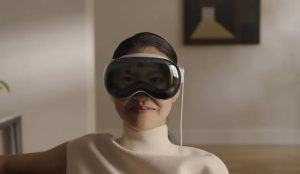
Inside the Vision Pro, it’s not just about internal screens; there’s an intriguing one on the front that sets it apart. Encased behind a curved laminated glass is Apple’s EyeSight screen. This innovative feature displays your eyes externally based on the feed from the internal cameras. The screen activates when someone enters your field of vision, exposing your “eyes” to those nearby. Meanwhile, the people around you become visible in your augmented reality (AR) experiences. Initial user tests have evoked a mix of amazement and eerie discomfort. The outcome remains to be seen, but any efforts to enhance the social aspect of wearing headsets or to maintain immersion without removing the device are encouraged.
APPLE VISION PRO: SOUND AND AIRPODS
Vision Pro boasts cutting-edge Spatial Audio capabilities, driven by two advanced “AudioPods.” These AudioPods utilize a dual-driver configuration, adapting Spatial Audio to your unique head and ear geometry, providing an immersive simulated surround sound encounter.
The recently introduced USB-C AirPods Pro 2 from Apple are positioned as a crucial companion for the Vision Pro headset. The latest version of the AirPods Pro 2 features an enhanced chip design, enabling high-resolution audio playback and minimizing latency between on-screen visuals and the corresponding audio experience in your ears.
APPLE VISION PRO: HANDS-FREE CONTROLS AND EYE TRACKING
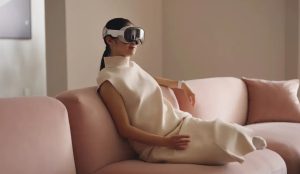
When utilizing Apple Vision Pro for navigating apps and interfaces, you take control. Hand gestures serve as the primary means of navigating apps and menus, eliminating the need for a wand or remote to explore the headset’s software. The onboard sensors are highly responsive to hand movements; Vision Pro can even detect subtle gestures like tapping a finger and thumb together, even if your hands are at rest in your lap. This pinching movement serves as the equivalent of a tap or click in the headset’s operating system, while flicks and swipes allow for scrolling through panes and pages.
If the need arises, you can connect Bluetooth peripherals such as a keyboard, trackpad, gamepad, or mouse for situations where a familiar typing experience or traditional game input is preferable. Siri is also integrated, enabling speech input for navigating the headset’s features. Additionally, a Visual Search system employs image recognition to identify objects in your field of view or read aloud text, providing multiple ways to interact with Vision Pro.
Eye Tracking and Optic ID security
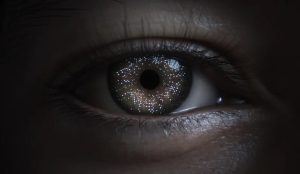
or hands-free input accuracy, the headset incorporates eye tracking. Vision Pro features a high-speed camera and a ring of LEDs projecting light onto your eyes, facilitating the identification of your gaze and reinforcing the intent of your hand gestures. The security system, known as ‘Optic ID,’ utilizes eye-tracking to scan your unique iris, ensuring that only registered users can access apps and data. A ‘Guest Mode’ is included, allowing multiple users to enjoy the headset, though it’s unclear if this involves temporary invitations or individual profiles with separate app data, such as for a family of users. Regardless, Optic ID also verifies log-in data in apps like Safari and ensures secure transactions with Apple Pay. Apple emphasizes local processing, ensuring that websites on the built-in browser only receive information about clicks, not your gaze location. Third-party apps also remain uninformed about the contents of your living room.
APPLE VISION PRO: CAMERAS AND 3D CAPTURE
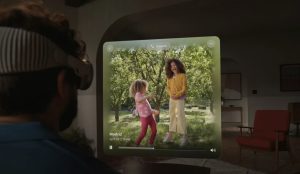
Vision Pro introduces Apple’s inaugural 3D camera, allowing you to preserve your memories in an immersive 3D format accompanied by spatial audio for a richer playback experience. With Vision Pro, you can seamlessly access your entire iCloud Photo Library and witness Panorama shots expanded, providing the sensation of standing at the original capture location.
A standout feature that will undoubtedly captivate users is Spatial Memories. This feature takes your experience beyond a mere photograph, as the onboard cameras record 3D videos with depth, immersing you in a lifelike playback of the scene. Notably, those being recorded will be alerted by a visible recording icon on the front EyeSight panel, addressing concerns about unexpected captures.
Enhancing this capability, the latest iPhone 15 Pro and iPhone 15 Pro Max can record Spatial Memory videos, which can later be transferred to the Vision Pro headset. This means you can capture these unique clips even when the Vision Pro is not physically present.
APPLE VISION PRO: WHAT CAN IT DO?
The Apple Vision Pro offers a multitude of applications, providing users with an expansive virtual screen. It’s essential to note that this isn’t your typical VR headset; it’s an AR headset. While it may not support ‘room-scale’ experiences that immerse you entirely in digital worlds, it does offer seemingly boundless space for your apps and projects, seamlessly integrated with the real world.
At the core of this experience is the all-new operating system, visionOS. Drawing inspiration from the familiar foundations of iOS and macOS, visionOS incorporates recognizable icons and Apple-style menu and file structures. However, it is specifically designed to harness the capabilities of augmented reality.
Anticipate visionOS versions of popular apps such as Apple TV Plus, Music, Photos, Freeform, Safari, Notes, Messages, Mail, and more within the headset. Additionally, exclusive hardware-specific apps will be available. The App Store will enable users to explore the Vision Pro software library, encompassing thousands of iPhone and iPad apps. A vast array of 2D apps can be utilized within Vision Pro, appearing as floating panes within the operating system.
To support app development for the Vision Pro headset, Apple is conducting developer-focused sessions globally. These sessions will take place in Cupertino, Sydney, Singapore, London, Munich, New York City, Tokyo, and Shanghai. Participants will attend one-day developer labs, offering hands-on experience with visionOS, iPadOS, or iOS apps on Apple Vision Pro.
Online ‘one-to-one’ consultations, presented as an “online multi-activity challenge,” will be hosted from Apple offices in the USA, Europe, and Asia. Participants can engage in sessions, meet with Apple experts, and prepare their apps or games for the all-new App Store for Apple Vision Pro.
These sessions aim to explore the foundational aspects of spatial computing, introduce the development framework, tools, and core technologies of visionOS, and impart best practices for creating human-centered experiences.
Using intuitive gestures and swipes, users can arrange various apps and workflows around them, resizing windows to considerable dimensions. This includes activities such as playing immersive Apple TV Plus videos, utilizing Continuity features with Mac applications, engaging in FaceTime video calls, and more. The following outlines some of the most captivating features observed thus far.
Entertainment, Environments and gaming
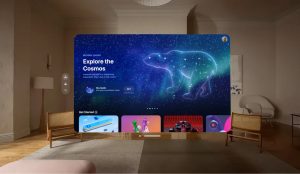
Vision Pro offers a remarkable way to enhance your entertainment experience with movies, TV shows, and games. It has the capability to generate virtual movie theater screens spanning up to 100 feet wide, coupled with advanced Spatial audio playback. This isn’t just about enlarging 2D content; for instance, upcoming shows like the new Godzilla series will provide Spatial Video support, allowing the iconic monster to seemingly rampage around your living room in a three-dimensional spectacle.
The advantages of spatial computing extend to gaming on these expansive virtual screens, supporting popular controllers and Apple Arcade games. Unity, the renowned game engine professionals, are confirmed to be part of the game development process, promising unique gaming experiences that leverage the features of Vision Pro.
Apple has partnered with Disney to bring Disney Plus to Vision Pro upon its launch. Although specific details are pending confirmation, anticipated features include immersive settings for shows such as The Mandalorian. Imagine watching the show in your own landspeeder on the sandy Star Wars planet of Tatooine. Other hinted features involve a virtual Mickey Mouse frolicking around your home and bird’s-eye views of NBA games unfolding on a tabletop in your living space, resembling a miniature board game. Unfortunately for Netflix enthusiasts, there won’t be a dedicated Apple Vision Pro Netflix app—at least not initially.
For those seeking a more relaxed experience with Apple Vision Pro, the company introduces an application called Environments. This feature showcases intricately detailed recreations of both real (forests, beaches) and unreachable (the surface of the moon) places. Controlled by the Digital Crown, Environments allows you to transport yourself to virtual locations worldwide from the comfort of your sofa. These environments can be seamlessly integrated with 3D video playback options, enhancing the overall immersive experience.
Work and productivity
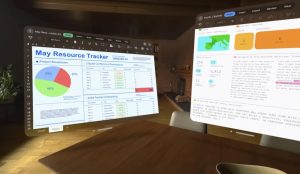
While the allure of entertainment features may attract casual users, Apple envisions Vision Pro as not only a source of amusement but also a powerful tool for productivity and enterprise purposes. Preliminary glimpses of the headset showcase individuals engaging in work-related tasks such as handling spreadsheets, documents, and 3D modeling applications within the Vision Pro. Notably, established applications like Final Cut Pro are slated to provide Vision Pro support in the future, with numerous others expected to follow suit.
Integral to this emphasis on professional applications is Apple’s Continuity system, a pre-existing feature that facilitates seamless collaboration across iPhone, iPad, and Mac devices by enabling the sharing of files, clipboards, and even peripherals. With Vision Pro, this Continuity system is not only present but also enhanced. For example, the headset can identify a nearby MacBook Pro through Continuity, discern it as the user’s system, generate additional virtual displays surrounding the physical one, and leverage iCloud cloud storage to effortlessly share files across all connected devices. The potential of Vision Pro extends to the point where an external monitor may become obsolete, eliminating the need for a dedicated desk space.
FaceTime
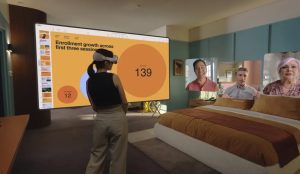
The Vision Pro experience will heavily feature FaceTime, where Apple envisions users engaging in video calls within the headset. During these calls with friends, family, or colleagues, virtual panes will surround you. However, if you’re the one wearing the headset, what does the person you’re calling see? A digitized version of yourself, courtesy of Vision Pro’s TrueDepth camera. This camera scans your face to create a digital ‘Persona,’ aiming to achieve a lifelike recreation of your features and expressions in real-time. Despite an impressive display so far, Apple is reportedly making significant strides in improving the quality of these Personas before the official launch.
Beyond lifelike avatars, Vision Pro boasts additional features, such as the ability to receive 3D objects in messages, allowing users to manipulate CAD-like attachments in a three-dimensional space.
APPLE VISION PRO: RELEASE DATE
Initially launching in the U.S. in early 2024, Vision Pro is expected to reach other countries later in the year. While rumors point to a January launch, potential delays could push it to February or March. With Apple’s tradition of a March event, that could be the opportune time for the company to confirm Vision Pro’s official release. Although one source suggests a January 27 release date, its limited track record and the fact that it falls on a Saturday make this less likely. Interested customers can explore Vision Pro at Apple Stores, where they can learn more about the headset and personalize the fit.
In the meantime, the visionOS SDK is available to developers, allowing them to create new apps and experiences ahead of the launch. The gap between announcement and release, while somewhat lengthy, aligns with the secretive nature of the project, now relying on outside developer support to enhance its appeal.
APPLE VISION PRO: PRICE
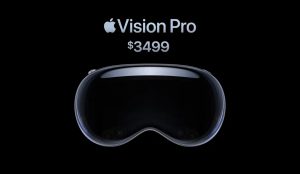
The Vision Pro headset starts at $3,499, surpassing the initially rumored $3,000 price tag. This places it significantly above the Meta Quest Pro and other headsets in terms of cost.




























